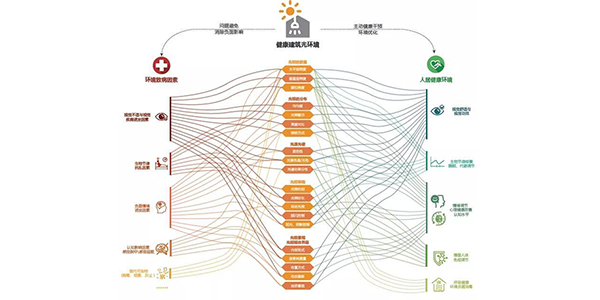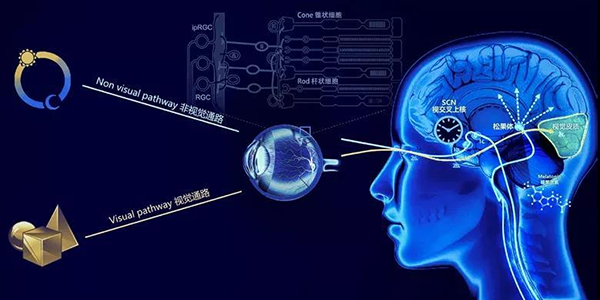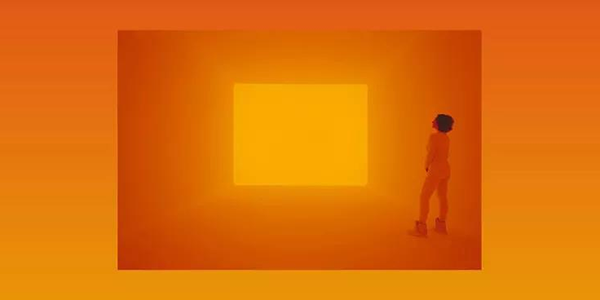Id-dawl għandu firxa wiesgħa ta 'effetti fuq is-saħħa viżwali tal-bniedem, ritmi bijoloġiċi, konjizzjoni emozzjonali, metaboliżmu u immunità permezz ta' effetti bijoloġiċi viżwali u mhux viżwali, u huwa teknoloġija ewlenija għas-saħħa tal-ħabitat tal-bniedem b'fokus komuni fl-oqsma tal-fruntiera tal-arkitettura, ottika, xjenza tal-ħajja u inġinerija ambjentali.
Ir-Rwol tal-fejqan tad-Dawl fl-Ispazju tal-Ħabitat
L-urbanizzazzjoni rapida wasslet għal żvilupp soċjoekonomiku u titjib tal-istandards tal-għajxien tan-nies, iżda ġabet ukoll sfidi serji għas-saħħa tal-bniedem. It-tixjiħ profond tal-istruttura tal-popolazzjoni, il-pass aċċellerat tal-ħajja soċjali, il-pressjoni dejjem tikber tal-kompetizzjoni fix-xogħol u l-istudju, u l-użu frekwenti ta 'apparat elettroniku intelliġenti wassal għal serje ta' problemi ta 'saħħa viżwali u żiedu wkoll ir-riskju ta' diversi fiżiċi. u mard mentali. Mis-sors tal-promozzjoni tas-saħħa, diversi tekniki, mezzi u metodi ta 'intervent tas-saħħa biex jirregolaw b'mod attiv l-istat ta' żbilanċ jeħtieġ li jiġu esplorati u żviluppati b'mod urġenti. Id-dawl huwa l-komponent ewlieni tal-ambjent fiżiku tal-ispazju tal-għajxien tal-bniedem u għandu effett multidimensjonali tas-saħħa ta '"viżwali-fiżiku-psikoloġiku". L-istandard WELL, li huwa rikonoxxut b'mod wiesa 'fil-qasam tal-bini b'saħħtu, u d-disa' elementi bażiċi ta 'bini b'saħħtu proposti miċ-Ċentru għall-Klima, is-Saħħa u l-Ambjent Globali tal-Iskola tas-Saħħa Pubblika ta' Harvard, it-tnejn jiffokaw fuq ambjent ħafif. Huwa ċert li permezz tal-issettjar raġonevoli tal-kwantità tad-dawl, id-distribuzzjoni tad-dawl spazjali, l-ispettru tas-sors tad-dawl u l-istrateġija tad-dawl, kif ukoll id-disinn personalizzat tal-pajsaġġ tad-dawl u l-interface tal-midja tal-arti ħafifa, huwa ta 'sinifikat konsiderevoli ta' riċerka li tuża d-dawl bħala dirett u mezzi effettivi, sikuri u mingħajr effetti sekondarji ta 'intervent tas-saħħa attiv fl-ambjent tal-għajxien tal-bniedem biex jiġu eliminati l-effetti negattivi kkawżati minn fatturi patoġeniċi ambjentali.
fatturi li jaffettwaw l-ambjent tal-ħabitat
Ambjent ħafif u saħħa viżwali
L-impatt tad-dawl fuq is-saħħa tal-bniedem huwa maqsum f'żewġ aspetti: viżwali u mhux viżwali. Aktar minn 80% tal-informazzjoni li l-bnedmin jiksbu dwar id-dinja esterna tinkiseb permezz ta’ mezzi viżwali. Għalhekk, il-kwalità viżiva taffettwa l-maġġoranza l-kbira tal-imgieba u l-attivitajiet bħax-xogħol, divertiment, interazzjoni u divertiment, u hija relatata mill-qrib mal-kwalità tal-ħajja. L-għajn hija l-aktar organu tal-bniedem sofistikat, u kundizzjonijiet ħżiena tad-dawl bħal dawl insuffiċjenti, dellijiet, dija, dawl strobe, u stimulazzjoni eċċessiva ta 'informazzjoni viżiva mhux biss se jwasslu għal funzjoni viżwali mnaqqsa, għeja viżwali, u prestazzjoni operattiva mnaqqsa, iżda wkoll ifixklu il-prestazzjoni bla xkiel tal-attivitajiet, u l-effetti kumulattivi tagħhom fit-tul se jikkawżaw mijopija, jaċċelleraw id-deġenerazzjoni makulari, u jġibu ħsara viżwali irriversibbli. Iċ-Ċina tinvesti ħafna riżorsi umani u ekonomiċi fil-protezzjoni nazzjonali tas-saħħa viżiva kull sena, u t-titjib tal-ambjent ħafif tal-ispazju tal-għajxien tal-bniedem huwa wieħed mill-kompiti ewlenin.
Hemm relazzjoni kumplimentari bejn il-funzjoni viżwali tal-għajn tal-bniedem, ix-xogħol viżwali u l-ambjent tad-dawl. Saru numru kbir ta 'studji dwar it-tqabbil tal-kapaċità viżiva ta' popolazzjonijiet varji bħall-adolexxenti, l-adulti u l-anzjani b'kundizzjonijiet operattivi differenti bħal karta, VDT u ipproċessar fin, biex jinkisbu l-parametri tal-ambjent tad-dawl meħtieġa għall-aħjar prestazzjoni viżwali. u kumdità viżwali. Taħt l-isforzi bla waqfien ta 'organizzazzjonijiet akkademiċi u riċerkaturi rappreżentati mis-CIE u l-istudjuż Amerikan Perter Boyce, ġie ffurmat kunsens dwar l-impatt ta' elementi individwali tad-dawl ambjentali bħall-illuminanza, il-luminanza, id-distribuzzjoni tal-luminożità tal-kamp viżiv, il-kulur tas-sors tad-dawl u l-għoti tal-kulur fuq il-viżiv. kwalità, u diversi standards u speċifikazzjonijiet tal-industrija ġew introdotti fid-dar u barra biex jiggwidaw il-prattika tad-disinn tal-ambjent tad-dawl arkitettoniku.
Ritmi ħfief u bijoloġiċi
Il-ġisem tal-bniedem għandu arloġġ speċjali msejjaħ "bijoritmu", li jirregola ħafna mill-proċessi fiżjoloġiċi bħall-irqad, l-għalf, il-metaboliżmu, it-tnixxija tal-ormoni u r-rispons immuni, u jżomm l-omeostasi b'saħħitha tal-ġisem. Disturbi tar-ritmu bijoloġiku jikkawżaw obeżità, kanċer, mard newrodeġenerattiv u mard ieħor, u jaffettwaw ukoll it-trattament u r-rijabilitazzjoni tal-mard. Minbarra ċ-ċelluli tal-koni u ċ-ċelluli tal-vireg, it-tielet tip ta 'ċelluli fotoreċetturi, ċelluli tal-ganglion fotoreċettur speċjalizzati tar-retina (ipRGCs), jeżistu fir-retina tal-mammiferi u huma fotosensittivi għal stimuli tad-dawl u jipproġettaw sinjali tad-dawl liċ-ċentru tal-kontroll tar-ritmu - Huma kapaċi jipperċepixxi direttament stimoli tad-dawl u jipproġetta sinjali tad-dawl għan-nukleu suprakjażmatiku (SCN), li jifforma l-mogħdija viżwali mhux immaġini ta ' dawl u jinfluwenza s-sekrezzjoni ta 'melatonin pineal, cortisol u ormoni umani importanti oħra, u b'hekk jirregolaw ritmi bijoloġiċi.
Mogħdijiet viżwali u mhux viżwali ta 'azzjoni tad-dawl
L-effett ritmiku tad-dawl huwa fokus ċentrali tal-prattika tar-riċerka f'ambjenti tad-dawl tas-saħħa indotti mill-bniedem. Klassijiet, uffiċċji, sptarijiet, u spazji taħt l-art introduċew sistemi dinamiċi ta 'dawl ritmiku biex itejbu l-kwalità ta' l-irqad bil-lejl u l-attenzjoni mentali u l-viġilanza matul il-wakefulness bi nhar. L-istimulazzjoni ritmika saret indikatur ewlieni ta 'ambjent ħafif b'saħħtu, u l-valutazzjoni kwantitattiva tal-impatt tagħha issa hija fokus ġdid ta' attenzjoni f'oqsma relatati fid-dar u barra.
L-effett emozzjonali tad-dawl
Min-naħa l-waħda, John A. Schindler, tabib prattikanti fl-Istati Uniti, fil-ktieb tiegħu How to Live 365 Days a Year indika li sa 76% tal-mard huma relatati mal-burdata ħażina. Iċ-ċavetta għall-prevenzjoni tal-mard u l-promozzjoni tas-saħħa fiżika u mentali hija li jinżamm stat tal-moħħ ottimist u pożittiv billi tirregola l-emozzjonijiet b'mod razzjonali. It-terapija tad-dawl abjad qawwi ġiet introdotta fit-trattament tad-disturb affettiv staġjonali fis-snin tmenin b'effetti notevoli, u r-riżultati ta 'studji kliniċi sussegwenti wrew ukoll li d-dawl għandu effetti pożittivi fuq it-trattament tad-dipressjoni ta' wara t-twelid, sindromu premenstrual, u disturb affettiv mhux staġjonali. .
Min-naħa l-oħra, id-dawl, il-kulur u l-ispazju flimkien jiffurmaw ambjent viżwali li jwassal il-lingwa tal-emozzjoni, u jagħmlu dawl relatat mill-qrib mal-esperjenza konjittiva u emozzjonali tal-bniedem. John Flynn, pijunier fl-istudju tal-psikoloġija tad-dawl, wera li l-bidliet fl-ambjent tad-dawl se jqanqlu risponsi differenti għall-ispazalità, iċ-ċarezza viżwali, il-privatezza, il-pjaċir, ir-rilassament u l-kumplessità. L-impatt perċettiv viżwali tad-dawl u l-kulur huwa spiss użat biex jinħolqu sitwazzjonijiet u atmosferi spazjali li jimmobilizzaw emozzjonijiet u jevokaw sentimenti psikoloġiċi speċifiċi. Pereżempju, is-serje ta’ xogħlijiet tal-arti tad-dawl immersivi ta’ James Turrell jibnu esperjenzi emozzjonali li jvarjaw minn dak psikodeliku sa dak surreali permezz ta’ reżonanza sensorja fil-kuntest.
Immersive Light Artwork ta' James Terrell
Prospett ta 'Prattika Innovattiva għal Ambjent Dawl B'saħħtu fil-Ħabitat tal-Bniedem
Il-prattika u l-innovazzjoni ta 'ambjent ħafif b'saħħtu joriġinaw mill-insegwiment bla waqfien tas-saħħa tal-ħajja tal-bniedem u hija sħiħa ta' possibbiltajiet infiniti. Għalkemm in-nies fehmu l-effetti estensivi tad-dawl fuq il-vista, il-fiżjoloġija u l-psikoloġija permezz ta 'mogħdijiet newrali multipli, għad hemm mekkaniżmi ta' azzjoni aktar kumplessi li jridu jiġu esplorati. Bl-approfondiment tal-għarfien tan-nies dwar il-ħajja u s-saħħa, u l-konnessjoni dejjem aktar mill-qrib bejn it-teknoloġiji tal-informazzjoni diġitali bħal kostruzzjoni intelliġenti, big data, cloud computing, komunikazzjoni mingħajr fili u Internet tal-Oġġetti u spazju arkitettoniku u ħajja umana, il-forma u l-kontenut tan-nies. ħajja b'saħħitha qed tinbidel kontinwament, u d-definizzjoni u l-ambitu tar-riċerka tas-saħħa ħafifa se jiġu estiżi kontinwament u saħansitra maqluba.
Sors: Times Building
Ħin tal-post: Ottubru-28-2022







